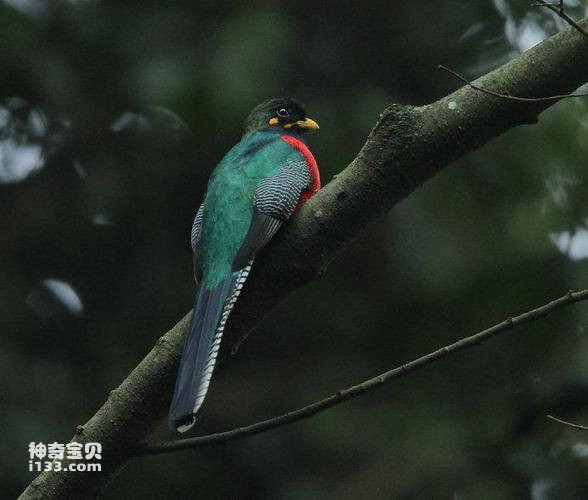Apaloderma vittatum
IUCN
LCBasic Information
Scientific classification
- name:Apaloderma vittatum
- Scientific Name:Apaloderma vittatum,Bar-tailed Trogon
- Outline:Climbing birds
- Family:
Vital signs
- length:About 28 cm
- Weight:No textual research information is available
- lifetime:No textual research information is available
Feature
The tail is long and broad, with black and white juvenile markings at the bottom
Distribution and Habitat
It is found in Angola, Burundi, Cameroon, Congo, Democratic Republic of Congo, Equatorial Guinea, Kenya, Malawi, Mozambique, Nigeria, Rwanda, United Republic of Tanzania, Uganda, Zambia.
It lives in forests and prefers to be about 1600 m above sea level, higher than that of the green-cheeked gnathen, but there are overlaps.
Appearance
The body length is about 28 cm. The beak and feet are yellow, and the tail is long and broad, with small black and white markings at the bottom of the tail. The male bird has a blue-black head with a copper-red sheen. There are two small yellow or orange featherless naked spots under the eyes, and yellow or gray spots on the eyes. The upper chest is purple to blue-green, while the rest of the lower body is red. The back is green, and the top of the tail is blue-black or purplish black. The female bird has a brown head, cinnamon-colored throat and chest, and the rest resembles the male. The young bird looks like the female, but has a white belly and pale spots on its wings.
It is small in size compared to other non-passerine birds, with gorgeous plumage, dense, soft feathers and well-developed secondary feathers. Caudal lipid gland bare; Dorsal plumage obvious, from neck to tail lipid gland, but not branching; Sex is different. The mouth is broad and short, the apex has a hook and a
Details
The Bar-tailed Trogon (Apaloderma vittatum) is a small climbing bird.

African biting cuckoos are arboreal, often single or in pairs, do not like to form groups, good at climbing but not good at walking and jumping; The flying force is not strong, although fast but not far, the flight route is fluctuating, mostly appearing in the middle and upper parts of the tree, but it is also frequently active on the ground. Flying in the forest is mostly up-and-down waves, very fast, but the flight distance is not too far. Timid and withdrawn, like a quiet environment, not good at singing, rest more hidden in a darker place. Feeding in the air and on the ground can hunt, mainly locusts, mantises, moths, butterflies, bees and other insects and their larvae, sometimes also eat snails and other small invertebrates and plant fruits, berries and seeds. Call monotonous, usually do not love to sing.
African biters breed in natural burrows of decaying trees in the forest or in ant nests and hives, and do not nest. Eggs are laid in a litter of 2-4 eggs. Nestlings are late sex. Brooding and brooding are shared by both parents.
Listed on the International Union for Conservation of Nature (IUCN) 2012 Red List of Threatened Species ver 3.1 - Low Risk (LC).
Protect wild animals and eliminate wild meat.
Maintaining ecological balance is everyone's responsibility!








